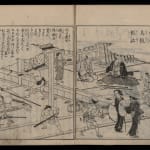Open a larger version of the following image in a popup:
 Volume 1, illustration of a busy gun shop in Sakai (port city in Izumi Province).
Volume 1, illustration of a busy gun shop in Sakai (port city in Izumi Province).
 Volume 1, illustration of a busy gun shop in Sakai (port city in Izumi Province).
Volume 1, illustration of a busy gun shop in Sakai (port city in Izumi Province).
Open a larger version of the following image in a popup:
 Volume 1, illustration of Shounji Temple in Sakai
Volume 1, illustration of Shounji Temple in Sakai
 Volume 1, illustration of Shounji Temple in Sakai
Volume 1, illustration of Shounji Temple in Sakai
Open a larger version of the following image in a popup:
 Volume 2, illustration of a knife shop in Sakai
Volume 2, illustration of a knife shop in Sakai
 Volume 2, illustration of a knife shop in Sakai
Volume 2, illustration of a knife shop in Sakai
Open a larger version of the following image in a popup:
 Volume 4, illustration showing visitors to hills covered with azalea enjoy picnics, a dance performance and walking
Volume 4, illustration showing visitors to hills covered with azalea enjoy picnics, a dance performance and walking
 Volume 4, illustration showing visitors to hills covered with azalea enjoy picnics, a dance performance and walking
Volume 4, illustration showing visitors to hills covered with azalea enjoy picnics, a dance performance and walking
Takahara Shunshosai (act. circa 1772-1801) (artist) Akisato Rito (act. circa 1780-1814) (author)
A Collection of Pictures of Famous Places in Izumi Province (Izumi meisho zue), 1796
Woodblock printed illustrated book, 4 volumes (complete)
Dated: 1796 (Kansei 8)
Publishers: Takahashi Heisuke, Ogawa Tazaemon, and three others
Binding: fukurotoji (pouch binding), light blue embossed covers
Dated: 1796 (Kansei 8)
Publishers: Takahashi Heisuke, Ogawa Tazaemon, and three others
Binding: fukurotoji (pouch binding), light blue embossed covers
25.8 x 18.2 cm. (10 ⅛ x 7 ⅛ in.) (each volume)
Volume 4 with postscript signed 'Rito Akisato Shoseki' and with two seals and dated 'Kansei shichinen kinoto-u' (1795)
Colophon signed: 'Shunchosai Takehara Nobushige', dated 'Kansei hachinen' (1796), and stating five publishers as above
Encased in a 20th century fitted blue linen board case with impressed gold leaf Japan Society Imperial chrysanthemum crest
Colophon signed: 'Shunchosai Takehara Nobushige', dated 'Kansei hachinen' (1796), and stating five publishers as above
Encased in a 20th century fitted blue linen board case with impressed gold leaf Japan Society Imperial chrysanthemum crest
£ 880.00
Further images
Izumi meisho zue is a late 18th century geographical guide to Izumi Province, present day Osaka Prefecture. Each volume features numerous double-page illustrations interspersed with double-pages of text relating to...
Izumi meisho zue is a late 18th century geographical guide to Izumi Province, present day Osaka Prefecture. Each volume features numerous double-page illustrations interspersed with double-pages of text relating to famous places of the region including shrines, temples, beauty spots, as well as regional specialities.
One double-page illustration shows a busy gun shop in Sakai, a large and important seaport. A samurai is offered tea whilst the shop proprietor presents him with an assortment of weapons to peruse. Gunmakers are hard at work to the left of the scene and various townspeople pass by the front of the shop.
Sakai evolved into Japan’s leading gunmaking hub during the late 15th to late 16th centuries and the trade continued to thrive throughout the Edo period (1603-1867). Surviving documents also show that orders for guns were being received from feudal lords and other members of the warrior class during this period.
Another double-page illustration depicts Shounji Temple in Sakai which was constructed between 1624 and 1643. At the time it was commonly called Matsu no Tera or "temple of the pines."
Other complete sets of Izumi meisho zue fully illustrated online are in the collections of:
University of Cambridge Library, go to: https://cudl.lib.cam.ac.uk/view/PR-FJ-00113-00039-00040/101
The National Diet Library, go to: https://dl.ndl.go.jp/pid/2563477
One double-page illustration shows a busy gun shop in Sakai, a large and important seaport. A samurai is offered tea whilst the shop proprietor presents him with an assortment of weapons to peruse. Gunmakers are hard at work to the left of the scene and various townspeople pass by the front of the shop.
Sakai evolved into Japan’s leading gunmaking hub during the late 15th to late 16th centuries and the trade continued to thrive throughout the Edo period (1603-1867). Surviving documents also show that orders for guns were being received from feudal lords and other members of the warrior class during this period.
Another double-page illustration depicts Shounji Temple in Sakai which was constructed between 1624 and 1643. At the time it was commonly called Matsu no Tera or "temple of the pines."
Other complete sets of Izumi meisho zue fully illustrated online are in the collections of:
University of Cambridge Library, go to: https://cudl.lib.cam.ac.uk/view/PR-FJ-00113-00039-00040/101
The National Diet Library, go to: https://dl.ndl.go.jp/pid/2563477
Provenance
The Japan Society Library, London1
of
8




